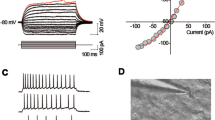Abstract
Histaminergic neurones send their axons to the whole forebrain. The diffuse projection is consistent with a modulatory role of these pathways. In hippocampal slices from rats a mechanism for this modulation is described, on pyramidal neurones of the CA 1 area: Strong excitations induced by intracellular current injection, ionophoretic administration of glutamate or synaptic stimulation normally restrict themselves by the activation of the calcium-dependent potassium current (gK(Ca)). This current causes a long lasting afterhyperpolarization and an accommodation of firing. Their block by histamine and impromidine (reversed by metiamide and cimetidine) leads to a profound potentiation of excitatory signals. It is suggested that HA, through H2 receptors, accelerates the removal of intracellular free Ca++ ions.
Similar content being viewed by others
References
M. Garbarg, G. Barbin, J. Feger andJ.-C. Schwartz,Histaminergic pathway in rat brain evidenced by lesions of the medial forebrain bundle, Science186, 833–835 (1974).
H.W.M. Steinbusch andA.H. Mulder, Distribution of histamine-immunoreactivity in the central nervous system of the rat. InHandbook of Chemical Neuroanatomy (EdsA. Björklund andT. Hökfelt). 1982. In press.
H.L. Haas andP. Wolf,Central actions of histamine, microelectrophoretic studies, Brain Res.122, 269–279 (1977).
H.L. Haas,Histamine hyperpolarizes hippocampal neurones in vitro, Neurosci. Lett.22, 75–78 (1981).
H.L. Haas andA. Konnerth,Histamine and noradrenaline decrease calcium-activated potassium conductance in hippocampal pyramidal cells, Nature302, 432–450 (1983).
D.A. Brown andW.H. Griffith,Calcium-activated outward current in voltage-clamped hippocampal neurones of the guinea-pig, J. Physiol., Lond.337, 287–301 (1983).
H.L. Haas, B. Schaerer andM. Vosmansky,A simple perfusion chamber for the study of nervous tissue slices in vitro, J. Neurosci. Meth.,1, 323–325 (1979).
D.V. Madison andR.A. Nicoll,Noradrenaline blocks accommodation of pyramidal cell discharge in the hippocampus, Nature299, 636–638 (1982).
J.A. Flatman andJ.D.C. Lambert,Sustained extracellular potentials in the cat spinal cord during the microiontophoretic application of excitatory amino acids, J. Neurosci. Meth.1, 205–218 (1979).
P. Andersen, S.H. Sundberg, O. Sveen andH. Wigström,Specific long-lasting potentiation of synaptic transmission in hippocampal slices, Nature226, 736–737 (1977).
M. Segal,Histamine modulates reactivity of hippocampal CA 3 neurons to afferent stimulation in vitro, Brain Res.213, 443–448 (1981).
J.G.R. Jefferys andH.L. Haas,Synchronized bursting of CA 1 hippocampal pyramidal cells in the absence of synaptic transmission. Nature300, 448–450 (1982).
J.P. Green, Histamine receptors in brain. InHandbook of Psychopharmacology, pp. 385–420 (EdsL. Iversen, S.D. Iversen andS.H. Snyder). Plenum 1983.
J.-C. Schwartz, M. Garbarg andH. Pollard, Histaminergic transmission in brain. InHandbook of Physiology, in press (1983).
Author information
Authors and Affiliations
Rights and permissions
About this article
Cite this article
Haas, H.L. Histamine potentiates neuronal excitation by blocking a calcium-dependent potassium conductance. Agents and Actions 14, 534–537 (1984). https://doi.org/10.1007/BF01973865
Issue Date:
DOI: https://doi.org/10.1007/BF01973865



